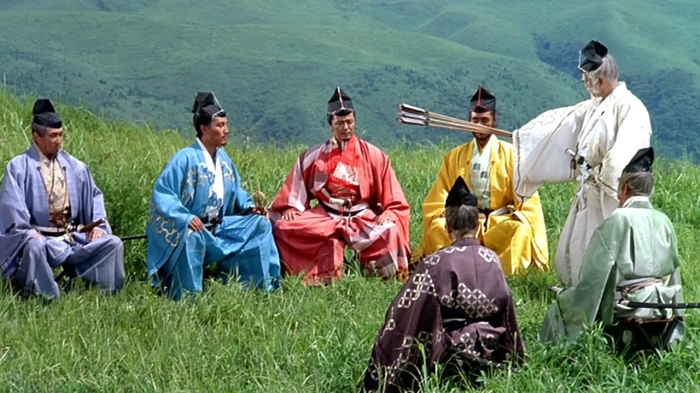At a castle set in the mountains, an aged Lord and his small retinue of soldiers and advisers are viciously attacked by armies led by two of his three sons. As the Lord’s retinue is gradually annihilated, the violence is observed in detached fashion, through a series of distant wide shots. Arrows and bullets fly in quick succession, horses trample on scores of bodies, blood seeps into the earth. The Lord, trapped in a burning tower, looks steadfastly down at the ground, visibly descending into madness. What is more, for most of this scene, there is no diegetic sound. We hear no shouts of aggression or pain, no gunshots, no songs of steel. The shocked viewer is left only with Toru Takemitsu’s brilliant score, elaborating this terrifying visual distillation of chaos, in which its actors appear to be almost ghostly.

It was not all so long ago that the same Lord sat on the side of a mountain, amicably addressing each of his three sons. Akira Kurosawa’s fearsome epic Ran begins with a political problem. Lord Hidetora is reminded through a dream of his looming mortality, and decides to give up most of his power to each of his three sons, Taro, Jiro and Saburo – though Hidetora expects to maintain the title of ‘Great Lord’. While Taro and Jiro accept graciously, Saburo attacks these plans, asking why he thinks his sons will be loyal to him, given that Hidetora has previously used violent means to maintain his own power. Enraged by this, Hidetora banishes Saburo, but in doing so loses his greatest advocate; it is not long before his other sons begin to violently contest his authority, while both are in turn held in thrall by the Machiavellian siren, Lady Kaede.

Those familiar with Shakespeare’s King Lear will immediately notice some parallels within the narrative. Shakespeare’s Lear also decides to relinquish most of his power to his (female) progeny, with disastrous consequences. King Lear inspires Ran with much of its story, but also with much of its visual landscape. There was a precedent to this. Back in 1957 Kurosawa had made Throne of Blood, based on Macbeth, which used almost no dialogue from the original text. Instead, the miasmic horror inherent in Shakespeare’s language was evoked through the cinematography. The ‘blasted heath’ was translated into copious amounts of rain and the thickest of fog, all filmed and controlled with precision by the director. In the case of Ran, the totalising language of chaos and disorder in King Lear is embedded within the initially wordless scene of violence already described, a masterpiece of visual scale and emotion.
Of course, that’s not to say that there aren’t many quieter moments in Ran; the overall pace is at times quite slow. In particular, the opening scenes of Hidetora with his sons are marked by leisurely formality, something accentuated by Kurosawa’s decision to use mostly wide shots rather than incorporating close-ups of faces and objects. This achieves a distancing effect – we observe the characters, safe in our seats, later to be horrified at the carnage of stormy ambition. But this apparently ‘slow’ style is consistent with his method at this point in time. Kurosawa made Ran late in his life, in his mid-70s, by which time he had lost almost all of his sight. He had spent a staggering ten years preparing every single shot in the film as a painting, from which those who worked on the film operated. While I wasn’t aware of this fact while watching the film, the painterly aesthetics of its wide shots were readily apparent. In one stunning sequence, Lord Hidetora emerges from the flaming building described above, walking slowly down a long flight of stone steps. He knows his soldiers and followers are all dead. He is flanked by the yellow-clad supporters of Jiro on the left, and the red-clad of Taro on the right. The placement of the soldiers forms a remarkable piece of symmetry which intentionally clashes with the unruly fire in the background; the lone Hidetora, his mind raging like the fire, meets the cold violent fact of military organisation. Framing is everything to Kurosawa, but also detail; 1,400 costumes and suits of armour were made for the film in a process spanning two years. It is difficult to imagine such effort being put into a film today.

That said, it’s also commendable that Kurosawa achieves some exhilarating performances from his cast. Especially commendable are Tatsuya Nakadai as Lord Hidetora and Mieko Harada as the scheming, murderous Lady Kaede. Nakadai, partly with the help of prosthetics, achieves the transition from venerable septuagenarian Lord to tortured, damaged vagrant with the greatest of passion. Passion also marks out Harada, although of a different kind; as she coaxes Taro and then Jiro into following her commands, you are never quite sure whether she will continue to speak quietly or snap into high-pitched, knife-wielding threats.

There are some films that are recognisably great, but which fail to stick long in the memory. Ran is so utterly unforgettable in its depiction of a world in turmoil (Kurosawa thought it was a metaphor for nuclear warfare), that it has compelled me to try and verbalise my experiences watching it, and in doing so to revive a film blog that I haven’t written on for nearly two years. Ran is for showing for a short while in a number of cinemas across the UK. If you get the chance to see it, you simply cannot miss it. It is a masterpiece from a director at the very top of his form, an epic driven not by copious CGI or contrivance, but by the patience of those who made it and the strength of its nihilistic convictions.
